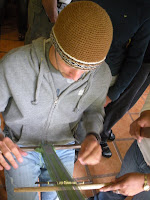So I’ve decided to split up this enormous blog entry into three parts, in order to cover everything between the beginning of April and now, and not to overwhelm any faithful readers in the process.
Thus begins Part I.
 After TES, our group returned exhausted but thrilled with their experiences traveling around Costa Rica. After learning all about the different ecosystems in Costa Rica and experiencing firsthand different sustainability projects, it led well into the next professor coming down for classes. Marty Michaelson came down to teach his week of Biblical Theology in Global Stewardship, so it gave the students even more of a chance to approach the topic of stewardship in their personal lives and from a biblical perspective. After TES and Global Stew, our students were feeling quite motivated to go back and change the world, recycling one tin can at a time. :)
After TES, our group returned exhausted but thrilled with their experiences traveling around Costa Rica. After learning all about the different ecosystems in Costa Rica and experiencing firsthand different sustainability projects, it led well into the next professor coming down for classes. Marty Michaelson came down to teach his week of Biblical Theology in Global Stewardship, so it gave the students even more of a chance to approach the topic of stewardship in their personal lives and from a biblical perspective. After TES and Global Stew, our students were feeling quite motivated to go back and change the world, recycling one tin can at a time. :) Following Marty’s week, the students had a full schedule. Three professors came down, Nancy Halliday, Carrie Bentley, and Sharon Young for her second time. Sharon continued to work with the students a little bit with the Entomology class, and Nancy was down to teach Tropical Medicine. Carrie is a new professor at SNU, so she came along to check out the location and the semester program. She also has a lot of experience with research, so she took the opportunity to sit down with each student and talk about the direction of their research project. Though late in the semester, those talks were valuable and encouraging to the students to finish their research strong.
Following Marty’s week, the students had a full schedule. Three professors came down, Nancy Halliday, Carrie Bentley, and Sharon Young for her second time. Sharon continued to work with the students a little bit with the Entomology class, and Nancy was down to teach Tropical Medicine. Carrie is a new professor at SNU, so she came along to check out the location and the semester program. She also has a lot of experience with research, so she took the opportunity to sit down with each student and talk about the direction of their research project. Though late in the semester, those talks were valuable and encouraging to the students to finish their research strong. Tropical Medicine was the focus for the week, with the students following the same schedule as with the other visiting professors and having class time every afternoon. However, unlike the other classes, this particular class incorporated a couple of extra elements. David and I had met and briefly gotten to know the chief of the indigenous tribe Boruca here in Costa Rica, so she and 2 other women came to visit and talk with the students about their customs and culture with a focus on how they utilize medicinal plants within their community. The workshops the gave to the students were incredible as they talked about their lifestyles, how they make a living, and the struggles they have as indigenous people being less than 1% of the population of Costa Rica. Toward the end of their workshop they actually did a demonstration of how they weave the cotton into thread and then how they use that thread to make all sorts of artisan goods like bags, purses, and belts. They are also famous for making Boruca masks, which are elaborately designed and painted in the shapes of animals from Costa Rica. The students took turns weaving, and were excited to purchase lots of handmade souvenirs from these women.



Later that week, the Tropical Medicine course took a field trip into San Jose. First stop was InBio, the Institute of Biodiversity. Here they received a lecture followed by a tour of the bioprospecting unit, which looks at the chemical properties in plants and animals and fungus to be used for medicinal purposes. After that, we headed to Clinica Biblica, one of the main private hospitals in San Jose. They received a talk from QERC’s main doctor, Dr. Longworth, and then a tour of the hospital. Everyone was impressed with the high quality of the equipment and facilities in the hospital.
The following week was the last week of visiting professors for the students. Frank Johnson, the Spanish professor at SNU, came down to finish up his week of teaching Applied Cultural Integration. The students had each done a project of their choice on an issue dealing with Latin America or Spain, and they each gave their presentations to Frank the week he was here. The other purpose for Frank coming down was to give the students a test over their Spanish ability. It wasn’t mandatory, but allowed for the students to possibly get credit for Spanish in addition to the other 15-17 credits they were receiving in other areas. Almost all students received at least 6 Spanish credits, with two of our students receiving 12 Spanish credits! It is a lot of fun to see them so excited about learning more Spanish, now that they have a desire to learn more and better communicate with Spanish-speakers they’ll come in contact with.


No comments:
Post a Comment